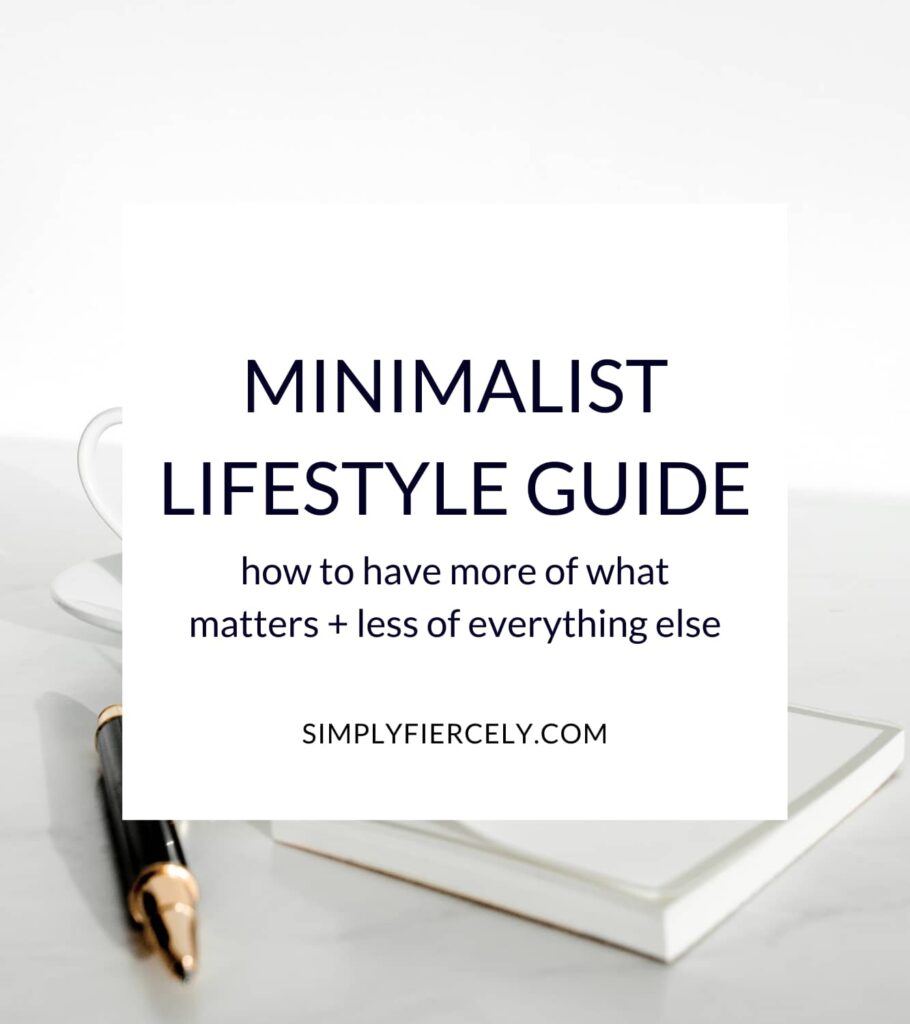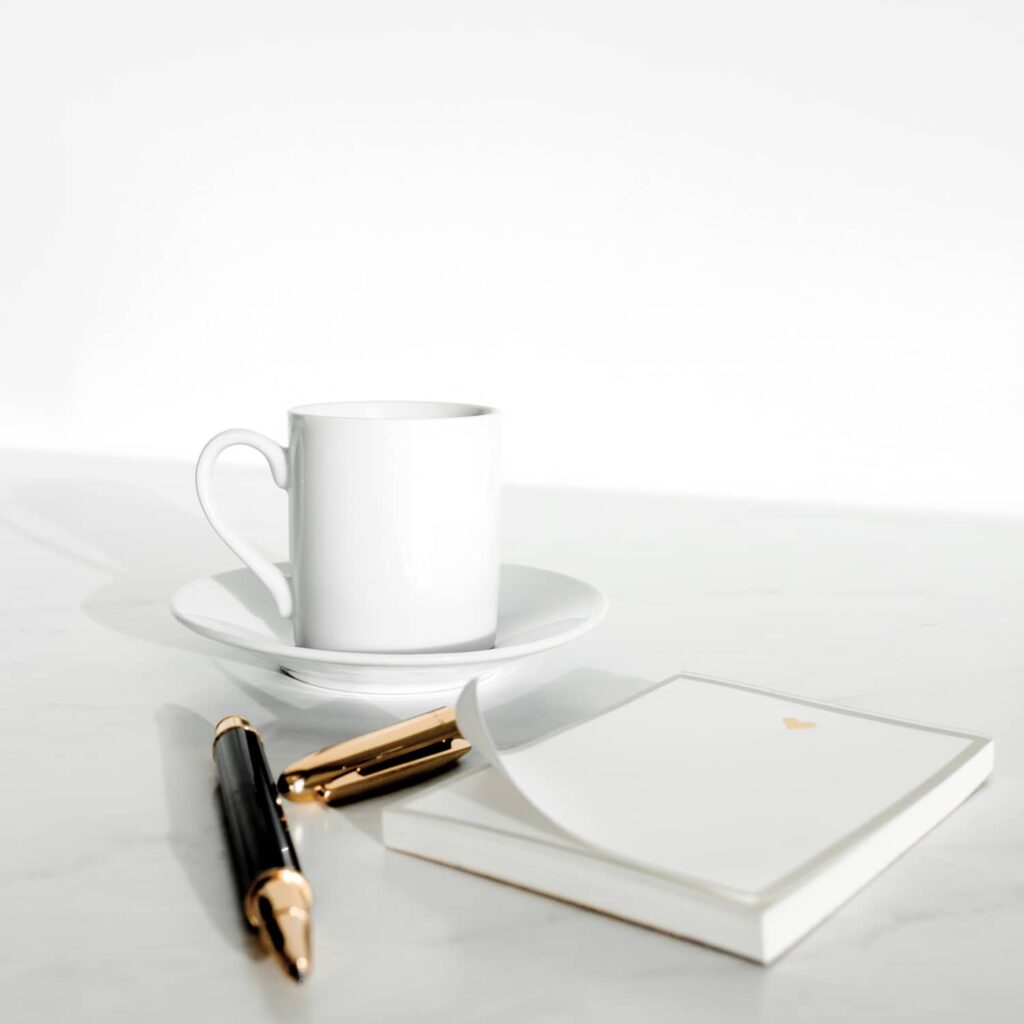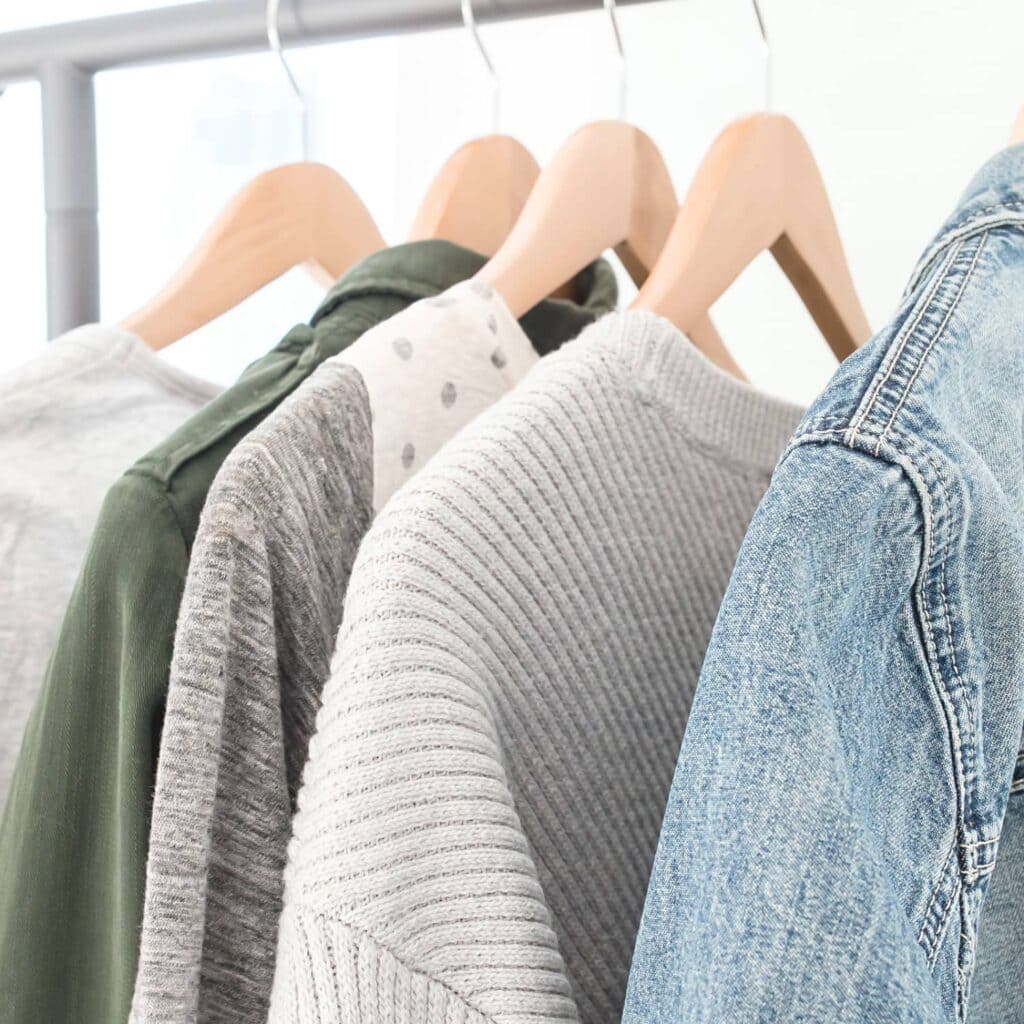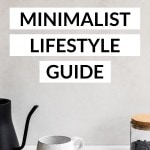It’s been nearly a decade since I began my journey from shopaholic to minimalist—but this doesn’t mean that I’ve forgotten how hard it can be to get started. I know exactly how overwhelming it can feel, which is why I’ve created this minimalist lifestyle guide for you!
If you’re interested in decluttering your home and life— so you can have more of what matters and less of everything else— then keep reading for everything you need to know.

What is the Minimalist Lifestyle?
A minimalist lifestyle is an intentional way of living where the things you own and do reflect your values and priorities. This means you probably have fewer possessions, but ultimately, it’s not about the stuff. Instead, it’s about creating alignment and curating your life to have more of what matters and less of what doesn’t.
In a sense, it’s really about decision making. Are your choices (about your possessions, your to-do list, or even your relationships) a reflection of what’s important to you? Or are you driven by fears, insecurities and a desire to keep up with the status quo?
From the outside, a minimalist lifestyle looks different for different people. My version might involve a 600 square foot inner-city apartment, and yours might be a 2000 square foot farmhouse in the country. By definition, minimalism is personal, and there are no arbitrary rules or limits.
If you want to learn more, I surveyed hundreds of readers about what it really means to be a minimalist. This is an excellent read for anyone interested in minimalism but feels uncertain about whether it’s right for them.
What Are The Benefits Of A Minimalist Lifestyle?
Some benefits of the minimalist lifestyle are obvious: less stuff to clean, less wasted money, and less wasted time! But did you know that’s just the beginning? When I reflect on my life before and after minimalism, it’s clear that so much more has changed.
- Minimalism taught me the art of intentional living. After years spent on auto-pilot (doing what was expected of me without question), I’m writing new rules and pursuing my definition of success.
- I developed self-confidence. Owning less meant no more hiding behind my possessions. My self-worth came from who I am and not from the latest handbag.
- My minimalist lifestyle gave me freedom to follow my dreams. With more time, money and enegy, I had space to experiment and try new things.
Ultimately, minimalism helped me save money, become debt-free, and explore an entirely new career path. I now have freedom, ease, and peace of mind that I once never dreamed possible.
The Limitations of a Minimalist Lifestyle
Before we go any further, I’d be irresponsible if I didn’t also mention some of the limitations of the minimalist lifestyle. I know that I’ve made it out to be great (and I genuinely believe it is!), but it is not a magic pill.
Decluttering a few bags of useless junk might feel good, BUT it won’t make all your problems go away overnight. The reality is that minimalism can be hard work—especially at first. It usually requires confronting some hard truths about why your life is busy and cluttered, which can be uncomfortable.
It also requires a long term commitment. Yes, you will notice some benefits of minimalism right away. Still, if you read my minimalist story, you’ll see that it took me years to really experience all the lifestyle changes I’ve mentioned today.
Ultimately, it’s important to remember that “minimalism” is not a project you check off your to-do list. It’s a lifestyle—and for some, an entirely new way of thinking and living. It can be challenging at first, but I promise that it’s a leap worth taking.

3 Key Elements of a Minimalist Lifestyle
Now that I’ve (hopefully) convinced you that a minimalist lifestyle is worth pursuing, let’s look at the three key elements of minimalist living.
1. THE MINIMALIST MINDSET
Believe it or not, I think the most essential part of creating a minimalist lifestyle is cultivating a minimalist mindset. When you learn to think like a minimalist, you become a minimalist.
Think of it this way—if you go on a crash diet, you might lose weight … but what happens when you stop dieting? I think we all know! A far better alternative to dieting is changing your mindset towards food and exercise, and the same applies to minimalism.
You can declutter your home, but if you haven’t changed the way you think, what happens when you stop decluttering? Unless you know how to genuinely want less, then odds are you will slowly fill your home again.
And it doesn’t stop with our stuff—we can also struggle with our schedules if we don’t have the right mindset. I experienced this after the birth of my daughter. I realised that I had let my to-do list and productivity define my self-worth for years, so when that was taken away, I felt lost. I didn’t know how to do less, and it was an eye-opening reminder about the power of mindset.
Learn more about the minimalist mindset:
2. DECLUTTERING
The next key element of minimalist living is decluttering.
I’ll be sharing some decluttering tips and advice later in this article, but the most important thing to know about decluttering is that it’s not really about what you get rid of. Instead, it’s about what you decide to keep. Ask yourself:
- What matters most to me?
- What am I creating space for?
- What kind of life do I want to live?
It’s about carefully curating your life so that what’s on the outside reflects what you want most on the inside. Decluttering is simply a tool, a bit like a sculptor chiselling away at the excess stone to reveal the masterpiece within. The sculptor doesn’t care about the off-cuts—it’s what’s left that really matters.
3. MORE OF WHAT MATTERS
The final and often forgotten element of minimalism is doing more of what matters.
Yes—more.
Minimalism is not about decluttering for the sake of decluttering; it’s not about deprivation, it’s not about willpower, and it’s not a competition to see who can live with the least stuff.
Instead, it’s about having an abundance of whatever matters most to you. It’s important not to forget this final step because, without it, minimalism can become yet another way of obsessing about stuff.
How Do I Start a Minimalist Lifestyle?
The steps to starting a minimalist lifestyle include: getting clear on your vision, reducing mindless shopping, decluttering, and eventually, being intentional in all areas of your life.
I’ve put together several helpful guides that explain it all in more detail:
- Minimalist Lifestyle Checklist: How to Get Started With Minimalism
- How to be a Minimalist: 5 Things Not to Do + What to Do Instead
- How to Live A Minimalist Life (A Complete Blueprint)
- How to Create a Minimalist Home (10 Simple Tips)
- 6 Minimalism Goals for The New Year and Beyond
You might also like to check out these minimalist challenges for fun experiments on living with less.
Minimalist Lifestyle Inspiration
When I was new to minimalism, I found that hearing other people’s stories really inspired me. I’ve put together this list to hopefully inspire you as well.
- 3 Real Life Minimalist Stories That Will Inspire You
- 7 Inspiring Books on Minimalism + Simple Living
- 5 Inspiring TED Talks About Minimalism + Simple Living
How to Declutter Your Home and Life
Minimalism is about so much more than decluttering, but there’s no denying that decluttering is an essential part of the journey. Here are resources and tips that will help you clear the clutter.
Free Decluttering Guide + Workbook
The first thing I recommend doing is downloading Mindful Decluttering, my FREE decluttering guide and workbook.
You’ll get my step-by-step decluttering process, my top troubleshooting tips, as well as a few personal stories to inspire you. Get your free copy by subscribing using the form below:
MINIMALIST DECLUTTERING TIPS
Here are some of my top decluttering tips:
- What To Do When You’re Overwhelmed By Clutter
- Where to Start Decluttering Your Home (5 Quick + Easy Ideas)
- 20 Simple Things You Can Do To Declutter and Live Minimally
- 4 Thoughtful Questions to Ask When Decluttering
- 8 Tips That Will Help You Find Motivation to Declutter
More Minimalist Lifestyle Tips
Here is a round-up of my top minimalist lifestyle tips. These tips will help you find simplicity in all areas of your life.
Minimalist Routines
- My Minimalist Daily Routine: Embracing Slow + Simple Every Day
- How to Spend Less Time Cleaning: My Minimalist Cleaning Routines
Minimalist Beauty + Fitness
- How to Create a Minimalist Beauty Routine (Skincare + Makeup Essentials)
- A Minimalist Approach to Fitness
Minimalism in the Kitchen
- Simple Eating: How I Learned to Save Money, Reduce Stress + Spend Less Time in the Kitchen
- How to Create a Minimalist Pantry For Your Kitchen
Minimalism + The Holidays
- How to Celebrate a Minimalist Christmas + Simple Holiday Tips
- Clutter-Free Minimalist Gifts: Ideas For Everyone On Your List
Mental Minimalism
Minimalist Family Lifestyle
- A Helpful Guide to Minimalism With Kids
- Minimalism for Mothers [An Essay on Simple Living + Motherhood]

Minimalist Wardrobe Tips
I decided to put my minimalist wardrobe tips in its own section because I know that it was my biggest challenge when I first started experimenting with minimalism!
- 20 Minimalist Wardrobe Tips: How to Have a Minimalist Closet
- Behind the Scenes: A Minimalist Wardrobe Tour (Video)
- Minimalist Winter Outfits + How to Make The Most of Your Closet
- Inspiration and Ideas for a Minimalist Spring Capsule Wardrobe
- How to Declutter Your Closet For Good: An Ultimate Guide
If you enjoyed this post, be sure to pin it or bookmark it for later because I’ll be updating this guide as I publish new posts— I still have a lot to say about minimalism!
If you have any questions or feedback, please let me know in the comments! I’d love to hear from you!


Loving the minimalist lifestyle.
Hi Jennifer! Great post! I would like to get your opinion on my situation.
I am 61, still work full time, and also live with my aging mother and do a lot to take care of her when I’m home.
She lives life “old school”, steeped in traditions from way WAY back. Being the middle child (yes I’m going to go there LOL!) I’ve always been one to try new things and I REALLY want to simplify my life. Based on your own admission that it took you years to really feel like you have accomplished the simplified life, in your opinion, am I too old to try this simplified life thing? How do I do that, given that I have the extra responsibility of taking care of an elderly parent who’s NEVER going to change? Thanks for sharing your journey and your insights.
Be blessed!
Hi Sue! I definitely think it’s never too late–keeping in mind that “simplicity” will look different for everyone. For example, I used to live in a small studio apartment and I could easily fit all my belongings into my small car! Now I have a daughter and I’ve upsized to a 2 bedroom apartment, and I definitely own a lot more than I used to! But this is what feels right for me during this season of life and your version of simplicity will need to feel right for yours.
Also, keep in mind that simple living is about more than just what you have in your home. It’s more a way of thinking … don’t be afraid to start small. Look at what you can control and slowly start to audit your life, making intentional decisions about what does or doesn’t belong. I’ve learned that it’s these little choices you make every day that really matter.
Best of luck and thank you for reading! x Jen
PS: If you haven’t seen it, you might find these posts helpful (this one about getting started https://www.simplyfiercely.com/minimalist-lifestyle-checklist/ and this one about enjoying the journey https://www.simplyfiercely.com/dont-wait-enjoy-simple-life/).